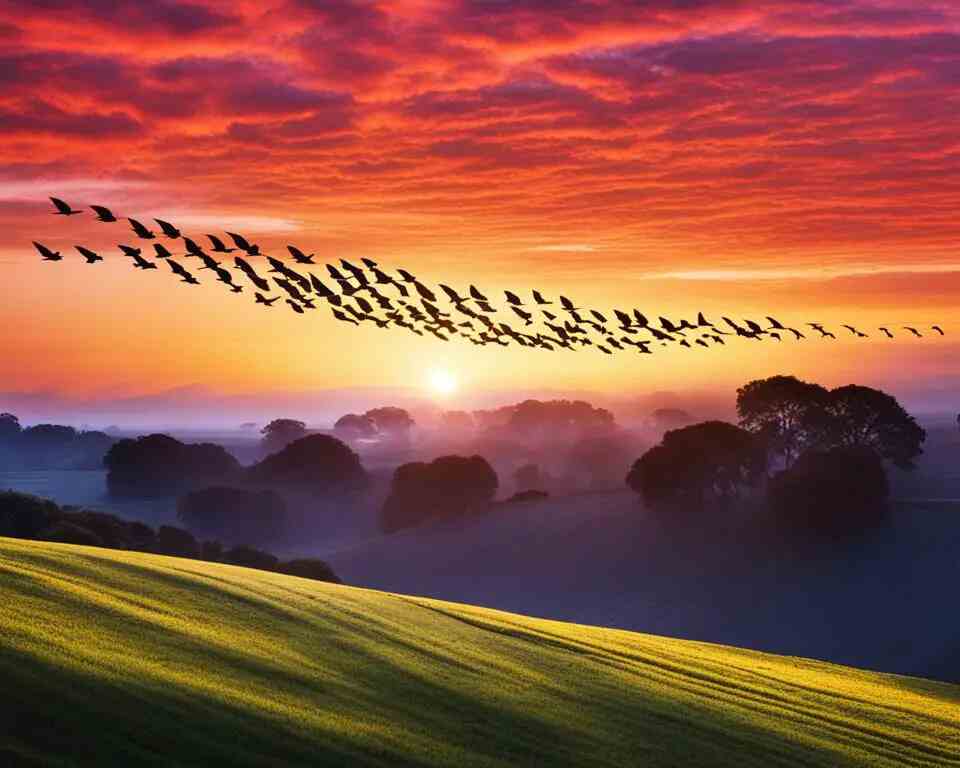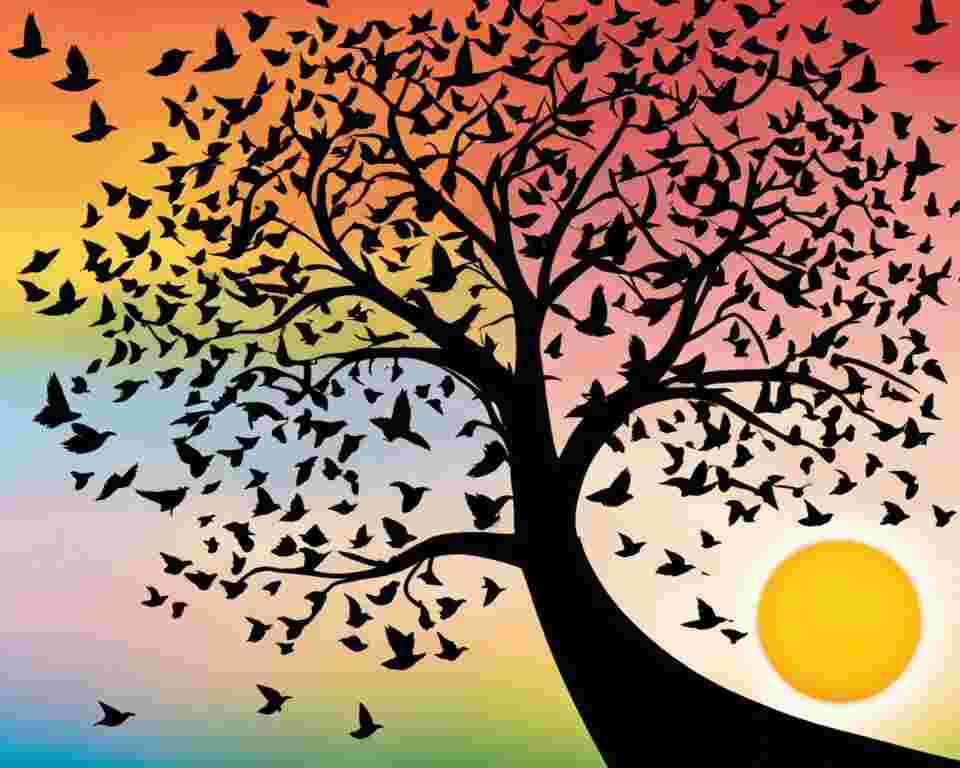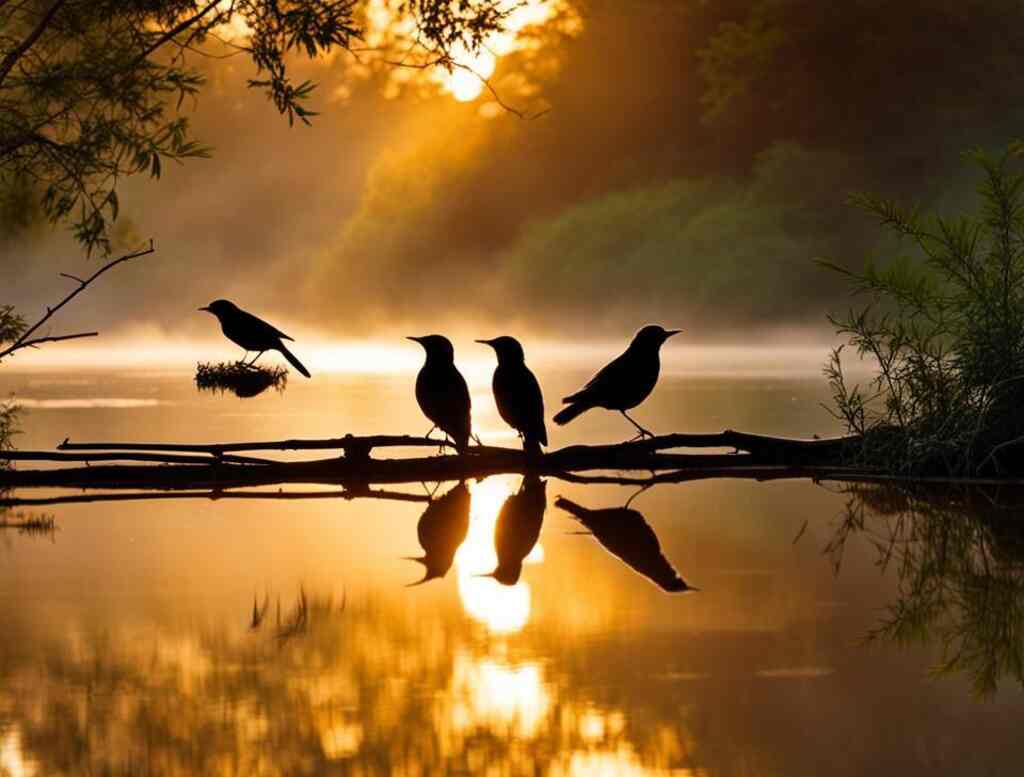As an avid birdwatcher, I have always been captivated by the diverse behaviors and exquisite beauty of birds. Over the years, my passion for observing these fascinating creatures has led me to explore the question: what time of day are birds most active? Understanding the peak bird activity timings is crucial to make the most of your birdwatching adventures.
In this article, I will look into the different patterns of bird activity and unveil the best times to observe birds in their natural habitats. Get ready to embark on an exciting journey through the avian world and discover the secrets of perfect birdwatching timing.
Table of Contents
- 1 Key Takeaways:
- 2 Understanding Bird Activity Patterns
- 3 What Time Of Day Are Birds Most Active
- 4 Dawn Chorus: Early Morning Birdwatching Insights
- 5 The Midday Lull: Bird Activity During the Day
- 6 Raptors and Sun: Late Morning to Early Afternoon Observations
- 7 Evening Resurgence: Late Afternoon and Dusk Birding
- 8 Conclusion
- 9 FAQs:
- 9.1 What are bird activity patterns influenced by?
- 9.2 What is the best time to observe birds?
- 9.3 Why is early morning a prime time for birdwatching?
- 9.4 What is the midday lull?
- 9.5 When is an opportune time to observe raptors?
- 9.6 When can I observe a resurgence in bird activity in the evening?
- 9.7 How can I enhance my birdwatching experience?
- 10 Source Links
- 11 Author
Key Takeaways:
- Understanding peak bird activity timings is essential for enhancing your birdwatching experiences.
- Bird activity is influenced by factors such as diurnal and nocturnal behavior, weather conditions, and foraging habits.
- The early morning, known as the dawn chorus, is a prime time for birdwatching, while the midday often experiences a lull in bird activity.
- Late morning to early afternoon is an opportune time to observe raptors, and late afternoon and dusk mark a resurgence in bird activity.
- Respect the natural habitats of birds and practice ethical birdwatching techniques for a rewarding and enjoyable experience.

Understanding Bird Activity Patterns
Bird activity patterns are influenced by various factors that govern their behavior. By understanding these patterns, birdwatchers can enhance their observations and increase their chances of spotting different bird species in action.
Diurnal vs. Nocturnal Bird Behavior
Diurnal birds are active during the day, while nocturnal birds are active at night. Diurnal birds, such as songbirds, raptors, and waterfowl, engage in a wide range of activities during daylight hours.
They feed, mate, defend territories, and engage in vocalizations. Nocturnal birds, such as owls and nightjars, have specialized adaptations for navigating and hunting in low-light conditions.
How Weather Influences Bird Behavior
Weather conditions have a significant impact on bird behavior. Temperature, wind, precipitation, and even seasonal changes can influence their activity levels. For example, many birds are more active during mild and calm weather, while others may prefer to take shelter during harsh conditions.
Migration patterns are also influenced by weather, with birds adjusting their movements based on favorable conditions for flying and finding food.
Bird Foraging Behavior and Feeding Times
Birds have specific foraging and feeding times that are closely tied to their natural habitats and food sources. Some birds are early risers and actively forage for insects and other prey in the early morning. Others may feed throughout the day, taking advantage of abundant food sources.
Understanding the feeding habits of different bird species can help birdwatchers plan their outings to target specific times and locations where bird activity is likely to be high.

What Time Of Day Are Birds Most Active
The time of day that birds are most active can vary based on several factors, including the species of bird, their habitat, and environmental conditions. While birds can be observed at any time throughout the day, there are certain periods when bird activity reaches its peak.
Understanding these optimal times for bird watching can greatly increase your chances of spotting a wide variety of bird species in action.
From observing bird behavior patterns, researchers have identified specific hours when birds are most active. These preferred activity hours can vary among different bird species and regions.
To get an idea of bird activity throughout the day, it’s helpful to consider the general trends in their behavior:
- In the early morning, birds are typically more active as they prepare for the day ahead. This period is often referred to as the “dawn chorus” and is known for its vibrant bird songs and territorial displays.
- During the midday hours, there is often a lull in bird activity. Many birds seek shelter in shaded areas to rest and conserve energy during the hottest part of the day.
- In the late morning to early afternoon, raptors, such as hawks and eagles, become more active. They take advantage of thermals, which are columns of rising warm air, to soar and hunt for prey.
- In the late afternoon and dusk, bird activity experiences a resurgence. This time is especially exciting at bird feeders, as many species visit for an additional meal before nightfall. Additionally, nocturnal species like owls and nightjars start to emerge during this time.
By familiarizing yourself with these peak bird activity periods, you can plan your birdwatching outings for optimal enjoyment and observation. Keep in mind that bird activity can also be influenced by factors such as weather conditions, availability of food sources, and the specific habitats you are exploring.

| Preferred Activity Hours | Main Bird Species | Peak Activity Behaviors |
|---|---|---|
| Early Morning | Songbirds, including robins, thrushes, and warblers | Calling, territorial displays, foraging for insects |
| Late Morning to Early Afternoon | Raptors, such as hawks and eagles | Soaring, hunting for prey, taking advantage of thermals |
| Late Afternoon and Dusk | Songbirds, owls, nightjars | Feeding at bird feeders, courtship displays, vocalizations |
Dawn Chorus: Early Morning Birdwatching Insights
The early morning, also known as the dawn chorus, is a prime time for birdwatching. It is during this time that songbirds engage in their morning rituals, including vocalizations to establish territory and attract mates. [Songbirds’ morning rituals]
In the quietness of the early morning, before the world wakes up, birdwatchers have the opportunity to observe birds in their natural behavior. This is a unique time when the lack of disturbance allows for a more intimate and immersive birdwatching experience. [Why early morning offers prime birdwatching]
To fully appreciate the dawn chorus, finding a peaceful spot in nature is key. As the sun begins to rise, the melodious symphony of bird songs fills the air, creating a serene and enchanting atmosphere. The soft glow of dawn adds a magical touch to the whole experience. It is a time of tranquility and beauty that brings joy to any birdwatching enthusiast.

The Midday Lull: Bird Activity During the Day
While the early morning is considered the peak time for bird activity, there is often a lull in the middle of the day. During this time, many birds retreat to shaded areas to rest and conserve energy. The midday lull is characterized by less frequent bird sightings and lower activity levels.
However, there are still opportunities to observe birds during this period, especially in areas with abundant food sources.
Raptors and Sun: Late Morning to Early Afternoon Observations
Late morning to early afternoon is an opportune time to observe raptors in action. These powerful birds of prey, including hawks, eagles, and falcons, take to the skies during this period, showcasing their remarkable hunting and flying abilities.
As the sun rises higher in the sky, creating thermals – columns of rising air, raptors capitalize on these natural updrafts to effortlessly soar and conserve energy.
Thermals and Their Role in Bird Flight
Thermals play a crucial role in the flight of birds, especially raptors. As the sun warms the earth’s surface, the air near the ground becomes heated and rises, creating thermal updrafts.
These rising columns of warm air provide raptors with an efficient means of ascending to higher altitudes without expending much energy.
By circling within thermals, raptors can gain altitude and survey the landscape for potential prey.
Spotting Birds of Prey in Daylight
Spotting birds of prey during daylight hours requires patience, sharp observation skills, and knowledge of their behavior. Look for birds soaring high in the sky, effortlessly gliding on the air currents. Raptors often circle within a thermal, gradually ascending while scanning the ground below for any signs of movement.
Keep an eye out for distinctive features such as broad wings, hooked beaks, and sharp talons, which are characteristic of birds of prey.
When observing raptors, pay attention to their flight patterns, as they may follow specific migration routes or hunting grounds. Researching the local bird migration patterns can give you valuable insights into where and when to spot these magnificent birds.
Additionally, be mindful of their preferred habitats, such as open fields, coastal areas, or forest edges, as they are more likely to be present in these locations.
Remember, always observe birds of prey from a respectful distance and never disturb their natural behavior.
Observing these remarkable creatures in their element is a privilege, and by practicing ethical birdwatching, we can ensure their continued presence and conservation for generations to come.
Evening Resurgence: Late Afternoon and Dusk Birding
As the day begins to wind down, late afternoon and dusk bring about a renewed burst of bird activity. This is an excellent time for birdwatchers to observe avian species, particularly at bird feeders. Many birds, including songbirds, flock to feeders during this period, seeking an additional meal before nightfall.
The evening hours witness a phenomenon known as “feeder frenzy,” offering birdwatching enthusiasts the opportunity to witness a vibrant assortment of avian species up close.
To fully appreciate the evening bird activity, leave your feeders well-stocked and positioned for easy observation. Place them within your line of sight, ensuring a clear view of visiting birds.
Pausing to observe their behavior and interactions can provide fascinating insights into their feeding habits and social dynamics.
Feeder Frenzy: Capture the Late-Day Avian Bustle
The sight of various birds clamoring around a bird feeder during the late afternoon and dusk creates a captivating spectacle. Songbirds, sparrows, finches, and other species engage in competition and share the available food resources.
This feeding frenzy allows birdwatchers to witness these vibrant interactions, providing an immersive experience in the world of birds.
To enhance your observation experience during feeder frenzy, consider using different feed types to attract a diverse range of bird species. Experiment with seed blends, suet, nectar, and fruit offerings to cater to the specific dietary preferences of various birds.
By providing diverse food options, you increase the chances of attracting a wide variety of species to your feeders.
Nocturnal Species: Owls and Nightjars Emerge
As evening settles in and dusk turns to darkness, a new cast of avian characters emerges – the nocturnal species. Owls and nightjars, renowned for their mysterious and elusive behaviors, begin to make their presence known. These fascinating birds take advantage of the cover of darkness to hunt for prey and engage in their unique vocalizations.
Spotting nocturnal species such as owls and nightjars requires patience and a keen ear. Listen for the distinct calls and hoots that these birds produce. By familiarizing yourself with their vocalizations, you enhance your chances of detecting their presence.
Remember, when observing nocturnal birds, it is important to use dim lighting or night vision equipment to avoid disturbing their natural behaviors and sleep patterns.
Conclusion
Understanding peak bird activity timings is essential for optimizing your birdwatching experience. By taking into account factors such as diurnal and nocturnal behavior, weather influences, foraging patterns, and specific times of the day, you can plan your outings more effectively.
Each time of day offers unique opportunities to observe different bird species and behaviors. The early morning, during the dawn chorus, provides a prime birdwatching time when songbirds engage in their morning rituals.
The midday lull may have less activity, but it can still offer opportunities to spot birds in shaded areas or near food sources. Late morning to early afternoon is perfect for observing raptors, taking advantage of thermals for their flight.
In the late afternoon and dusk, feeder frenzy occurs, attracting various species, while nocturnal birds like owls and nightjars make their appearance.
When engaging in birdwatching, it is important to respect the natural habitats of birds and practice ethical techniques. Remember to maintain a respectful distance, avoid disturbing nesting sites, and refrain from using flash photography.
Additionally, having the right equipment such as binoculars, field guides, and a birding journal can enhance your experience and help you identify different bird species more accurately.
So, whether you’re an avid birder or a beginner, utilizing the knowledge of peak birdwatching hours and applying these birdwatching tips will ensure a rewarding and enjoyable time in the great outdoors, connecting with the fascinating world of birds.
FAQs:
What are bird activity patterns influenced by?
Bird activity patterns are influenced by factors such as diurnal and nocturnal behavior, weather conditions, and foraging and feeding habits.
What is the best time to observe birds?
The best time to observe birds varies depending on species, habitat, and environmental conditions. However, early morning and late afternoon to dusk are generally considered prime birdwatching times.
Why is early morning a prime time for birdwatching?
Early morning, known as the dawn chorus, is a prime time for birdwatching because songbirds engage in their morning rituals, including vocalizations to establish territory and attract mates.
What is the midday lull?
The midday lull refers to a period during the day when many birds retreat to shaded areas to rest and conserve energy. Bird activity is typically lower during this time.
When is an opportune time to observe raptors?
Late morning to early afternoon is an opportune time to observe raptors in action. During this period, thermals become stronger, aiding bird flight, and raptors take advantage of these thermals to soar and hunt for prey.
When can I observe a resurgence in bird activity in the evening?
Late afternoon to dusk marks a resurgence in bird activity, especially at bird feeders. Many species, including songbirds, visit feeders for an additional meal before nightfall. Nocturnal species such as owls and nightjars also start to emerge during this time.
How can I enhance my birdwatching experience?
You can enhance your birdwatching experience by understanding peak bird activity timings, respecting the natural habitats of birds, practicing ethical birdwatching techniques, and exploring different times of the day for unique bird species and behaviors.


